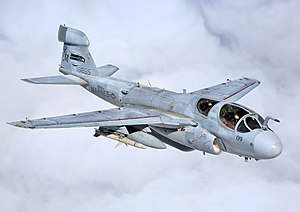
Back نورثروب غرومان إي إيه-6 بي براولر Arabic Grumman EA-6B Prowler Catalan Northrop Grumman EA-6B Prowler Czech Northrop Grumman EA-6B Prowler Danish Grumman EA-6 German Grumman EA-6B Prowler Spanish نورثروپ گرومن ئیای-۶بی پراولر Persian Grumman EA-6B Prowler Finnish Grumman EA-6 Prowler French EA–6B Prowler Hungarian
| EA-6B Prowler | |
|---|---|

| |
| Grumman EA-6B Prowler in flight | |
| Role | Electronic warfare/Attack aircraft |
| Manufacturer | Grumman Northrop Grumman |
| First flight | 25 May 1968[1] |
| Introduction | July 1971 |
| Retired | March 2019, U.S. Marine Corps |
| Status | Retired[2] |
| Primary users | United States Navy (historical) United States Marine Corps (historical) |
| Produced | 1966-1991 |
| Number built | 170 |
| Developed from | Grumman A-6 Intruder |
The Northrop Grumman (formerly Grumman) EA-6B Prowler is a twin-engine, four-seat, mid-wing electronic-warfare aircraft derived from the A-6 Intruder airframe. The EA-6A was the initial electronic warfare version of the A-6 used by the United States Marine Corps and United States Navy; it was used during the Vietnam War. Development on the more advanced EA-6B began in 1966. An EA-6B aircrew consisted of one pilot and three Electronic Countermeasures Officers,[3] though it was not uncommon for only two ECMOs to be used on missions. It was capable of carrying and firing anti-radiation missiles (ARMs), such as the AGM-88 HARM.[4]
The Prowler was in service with the U.S. Armed Forces from 1971 until 2019. It carried out numerous missions for jamming enemy radar systems, and in gathering radio intelligence on those and other enemy air defense systems. From the 1998 retirement of the United States Air Force EF-111 Raven electronic warfare aircraft, the EA-6B was the only dedicated electronic warfare plane available for missions by the U.S. Navy, the U.S. Marine Corps, and the U.S. Air Force until the fielding of the Navy's EA-18G Growler in 2009. Following its last deployment in late 2014, the EA-6B was withdrawn from U.S. Navy service in June 2015, followed by the USMC in March 2019.
- ^ "EA-6B Prowler". Warfighters Encyclopedia. Naval Air Systems Command. Archived from the original on 5 November 2004.
- ^ "VMAQ-2 – 44 Years of Electronic Warfare".
- ^ Bolkcom, Christopher (3 December 2001). Electronic Warfare: EA-6B Aircraft Modernization and Related Issues for Congress (Report). Library of Congress, Congressional Research Service. p. 4. Archived from the original on 6 February 2024.
- ^ Cite error: The named reference
:1was invoked but never defined (see the help page).
© MMXXIII Rich X Search. We shall prevail. All rights reserved. Rich X Search